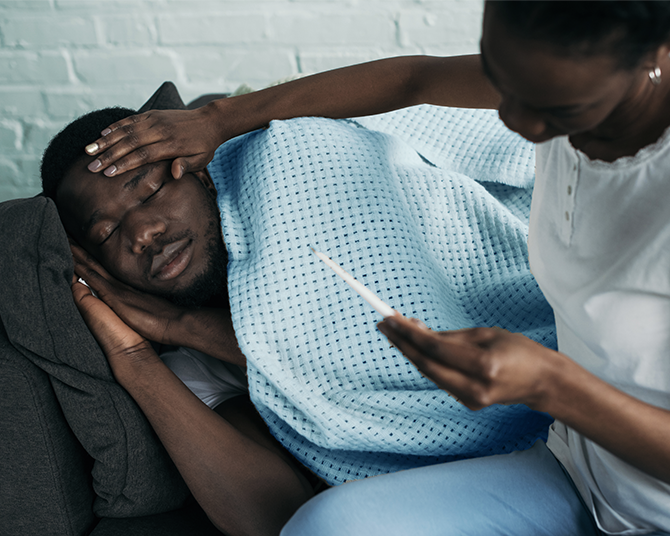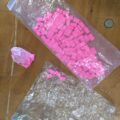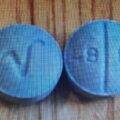A fever is a temporary increase in your body temperature, often due to an illness. Having a fever is a sign that something out of the ordinary is going on in your body. For an adult, a fever may be uncomfortable, but usually isn’t a cause for concern unless it reaches 103 F (39.4 C) or higher. The average normal body temperature is 98.6° Fahrenheit (or 37° Celsius). When you or your child’s temperature rises a few degrees above normal, it’s a sign that the body is healthy and fighting infection. In most cases, that’s a good thing.
There are several types of fever. When the body temperature increases to 100.4°F (38°C), it is called a low grade fever. A high grade fever happens when your body temperature is 103°F (39.4°C) or above. Most fevers usually go away by themselves after 1 to 3 days. A persistent or recurrent fever may last or keep coming back for up to 14 days.
A fever that lasts longer than normal may be serious even if it is only a slight fever. This is because a recurrent fever might be a sign of a more serious infection or health condition.
However, many people have learnt the act of faking a fever even when they do not have one. They do this to avoid meeting people, evade punishment, gain some benefits, evade school or work.
How people fake fever and how to spot them
People fake fever by using several methods which can include:
Garlic: Some people place a minced garlic or the garlic cloves under their armpits for 6-7 hours, this increases their body temperature and fool the thermometer.
How to Spot this method: Look out of any smell of ginger or garlic. Garlic has its own universally known scent– spicy, pungent and mellow.
Heated thermometer: Many run the thermometer under hot water when trying to convince someone they have a fever. They place the tip of the thermometer under a tap with warm water, and leave it there until the temperature go over 100.5 degrees Fahrenheit (38.1 degrees Celsius). Others hold the thermometer still with 1 hand and rub the tip fast to raise the reading on the thermometer.
How to Spot this method: This method usually lasts for about 2-3 minutes, to burst this method use the thermometer on yourself and wait for three minutes before using it on the patient.
Heating the forehead: To falsely create a fever, some press a hot water bottle against their forehead for a few minutes to make it feel warm to the touch. Others use a heating pad on a low setting to warm their forehead so that when someone comes in to check and feels forehead, it’ll be warm enough that they’ll think the fellow has a fever.
How to Spot this method: The easiest way to scientifically burst this method is to use a thermometer and the whole scam will fall like a pack of cards. A digital thermometer is best for taking temperatures by the armpit and mouth. Fever strips and pacifier thermometers do not give an accurate temperature. Do not use a mercury thermometer.
Eating spicy foods trick: Spicy foods, like jalapeños, chiles, or peppers, can actually increase body temperature. In general, hot, spicy foods are stimulants. They stimulate the circulation and raise body temperature. Eating spicy foods raises your internal body temperature so it will match the temperature outside of your body. This causes you to sweat and once the moisture is evaporated, your body is cooled off.
How to Spot this method: Look out for any smell of spicy foods, like jalapeños, chiles, or peppers or left over of spicy food around the person.
What type of thermometer is the most accurate?
The best thermometer is the one that you can use most comfortably and correctly. It’s also helpful if your thermometer comes from a reliable manufacturer.
Rectal thermometers are still considered by many medical professionals to be the gold standard for babies and children. However, oral and forehead readings are also typically very reliable in these age groups.
Always keep in mind that temperature readings vary, based on how the thermometer is administered:
- Rectal thermometer readings will be around 0.5°F (0.3°C) to 1°F (0.6°C) higher than oral temperature readings.
- Tympanic thermometer readings are typically 0.5°F (0.3°C) to 1°F (0.6°C) higher than oral temperature readings.
- Axillary thermometer readings can be 0.5°F (0.3°C) to 1°F (0.6°C) lower than oral temperature readings (and may be the least reliable).
- Temporal thermometer readings are often 0.5°F (0.3°C) to 1°F (0.6°C) lower than oral temperature readings.
How to take an oral temperature
To take temperature orally with a digital thermometer:
- Wash your hands.
- Make sure your thermometer is clean and has working batteries.
- Turn the thermometer on. Slip the plastic sheath over the bottom tip of the thermometer.
- The thermometer will indicate that it’s ready to be used with a sound, light, or both.
- Place the thermometer’s tip underneath the tongue. Some thermometers come with grooves that indicate how far into the mouth it should go.
- Keep your mouth closed until you hear a beep or similar type of sound.
- Remove the thermometer and read it.
- Rewash your hands.
- Clean the thermometer between uses according to the manufacturer’s directions, even if only one person is using it.
How to take a rectal temperature
To take someone’s temperature rectally with a digital thermometer:
- Wash your hands.
- Make sure your thermometer is clean and has working batteries.
- Cover the tip of the thermometer with a plastic sheath and apply lubricant, such as petroleum jelly or a water-based lubricant such as K-Y jelly.
- Babies can be placed on their backs, with their legs in the air. Children and adults may be more comfortable lying on their stomachs.
- Turn the thermometer on and wait for it to tell you it’s ready.
- Keeping the thermometer straight, gently insert the tip of the thermometer into the rectum, no more than 1 inch.
- Hold it in place so it doesn’t slip out.
- Wait to hear a beep or similar sound.
- Remove the thermometer and read it.
- Clean the thermometer according to the manufacturer’s directions before storing or reusing.
- Rewash your hands.
If your child is squirming, it may be hard to get an accurate reading. If so, remove the thermometer and use a different thermometer to take an oral, armpit, or forehead reading.
How to take temporal temperature with a no-touch forehead thermometer
No-touch forehead thermometers usually have a removable cap that keeps it clean during storage. Make sure you take the cap off before use.
- Activate the device with the power button. You’ll know it’s on if it lights up and a startup sequence loads.
- When your thermometer is ready, position it no more than 2 inches away from the center of the forehead. You can also touch the forehead with some models. Either way, you’ll get the most accurate reading possible if the forehead is clean and clear of hair.
- Many thermometers have a guidance light that takes the guesswork out of positioning.
- Make sure to hold the thermometer steady. The thermometer and forehead must be free of movement in order to get an accurate reading.
- Press the temperature button.
- Your device will beep or flash to let you know the temperature is ready to be read. This will only take around 2 seconds.
Instructions for forehead thermometers vary by manufacturer, so make sure to read and hold onto the instructions or user’s manual that come with your device. SEE: How to Spot Fake Medical Devices




